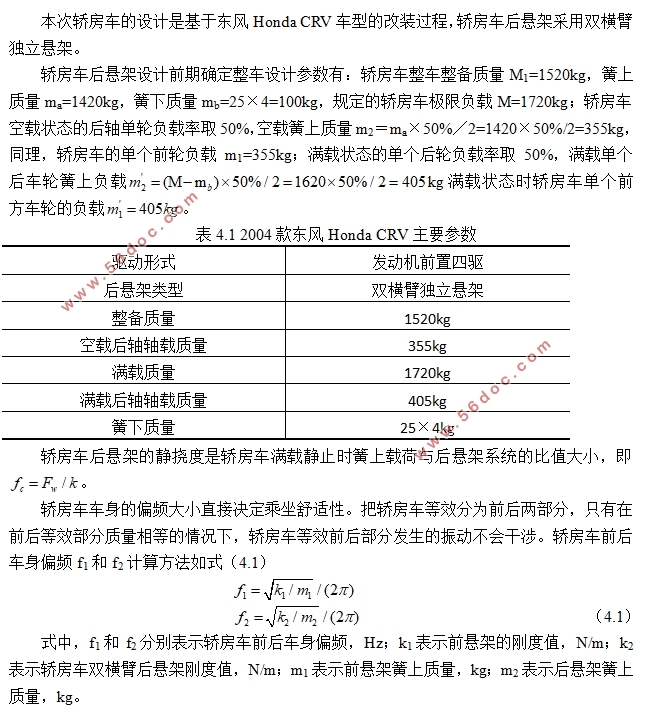轿房车后悬架(双横臂悬架)设计(含CAD零件图装配图)
来源:56doc.com 资料编号:5D25273 资料等级:★★★★★ %E8%B5%84%E6%96%99%E7%BC%96%E5%8F%B7%EF%BC%9A5D25273
资料以网页介绍的为准,下载后不会有水印.资料仅供学习参考之用. 密 保 惠 帮助
资料介绍
轿房车后悬架(双横臂悬架)设计(含CAD零件图装配图)(任务书,开题报告,论文说明书16000字,CAD图5张)
摘 要
轿房车是一种目前市面上还没有的全新车型,轿房车平常作为轿车使用,出去旅行是可以变形成房车使用。因此需要设计一种既能保证轿房车良好舒适性又能保证可靠性的轿房车后悬架。
根据汽车设计要求与步骤,再结合近年来汽车悬架领域的研究进展,本论文确定了轿房车后悬架的结构形式和主要参数,借助计算机辅助设计软件CATIA进行结构设计,并通过ANSYS软件进行强度仿真分析,通过ADAMS软件进行运动仿真解决运动干涉问题。具体设计分为以下四个过程。
(1)分析国内外汽车后悬架结构型式;确定轿房车后悬架类型。
(2)确定轿房车后悬架设计方案和技术参数。
(3)设计后悬架主要零部件并完成悬架装配。
(4)悬架强度和运动仿真分析。
结果表明所设计轿房车后悬架结构合理,强度符合要求。所得结果针对轿房车后悬架设计具有重要的参考意义。
关键词:轿房车;双横臂悬架;螺旋弹簧;仿真
Abstract
Saloon-Recreational Vehicle is a new concept car which has not existed in market. New Recreational Vehicle is used as saloon car in daily life, while it is used as recreational vehicle in period of travelling. Therefore, suspension need to be designed to meet the requirements of travelling comfort and reliability.
According to the requirements and steps of automotive design, coupled with recent advances of the research in the field of automobile suspended frame, This paper determines structure and main parameters of New Recreational Vehicle rear suspension. With the aid of computer aided design software CATIA structural design is accomplished, and strength analysis is accomplished by ANSYS. Beside, motion interference problem is solved by simulation software ADAMS. The concrete research process is divided into the following steps.
1) Analyzing domestic and foreign automobile suspension structure; determining its rear suspension type.
2) Determining rear suspension design scheme and technical parameters.
3) Designing the major parts of the rear suspension; completing the suspension assembly.
4) Suspension strength and motion simulation analysis.
Results show that the rear suspension structure is reasonable, the strength meets the requirement. The result has important guiding significance for suspension design.
Key Words:New Recreational Vehicle Double wishbone suspension Helical spring Simulation




目 录
第1章 绪 论 1
1.1 论文研究的目的及意义 1
1.2 国内外研究现状 1
1.3 设计的基本内容 2
第2章 国内外汽车后悬架结构型式分析 3
2.1 国内外后悬架基本结构形势分析 3
2.2 轿房车后悬架选型分析 4
2.3 本章小结 5
第3章 轿房车后悬架主要部件特性 6
3.1 后悬架弹性元件特性分析 6
3.2 后悬架减振器特性分析 6
3.3 本章小结 7
第4章 轿房车后悬架主要参数的确定 8
4.1 后悬架静挠度和动挠度 8
4.2 后悬架侧倾角刚度及其在前、后车轴上的分配 10
4.3 本章小结 10
第5章 轿房车后悬架及其部件的设计计算 11
5.1 轿房车双横臂后悬架导向机构设计 11
5.1.1 导向机构设计要求 11
5.1.2 导向机构的布置参数 11
5.1.3 悬架横臂的定位角 12
5.1.4 纵向平面内上、下横臂的布置方案确定 12
5.1.5 横向平面内上、下横臂的布置方案确定 13
5.1.6 双横臂悬架上下横臂长度的确定 14
5.1.7 本章小结 14
5.2 双横臂后悬架弹性元件设计 15
5.2.1 后悬架螺旋弹簧的刚度设计 15
5.2.2 弹簧刚度校核 17
5.2.3 本章小结 18
5.3 双横臂后悬架减振器设计 18
5.3.1 相对阻尼系数的确定 18
5.3.2 减振器阻尼系数的确定 19
5.3.3 减振器最大卸荷力F0的确定 20
5.3.4 筒式减振器工作缸直径的确定 21
5.3.5 本章小结 22
第6章 CATIA三维建模 23
6.1 弹性元件 23
6.2 减振器 24
6.3 导向机构 24
第7章 轿房车后悬架仿真分析 26
7.1 后悬架应力应变仿真分析 26
7.2 后悬架运动仿真分析 27
第8章 总结与展望 31
8.1 总结 31
8.2 展望 31
参考文献 32
附 录 34
MATLAB程序代码 34
MATLAB程序运行结果 36
致 谢 38
|









